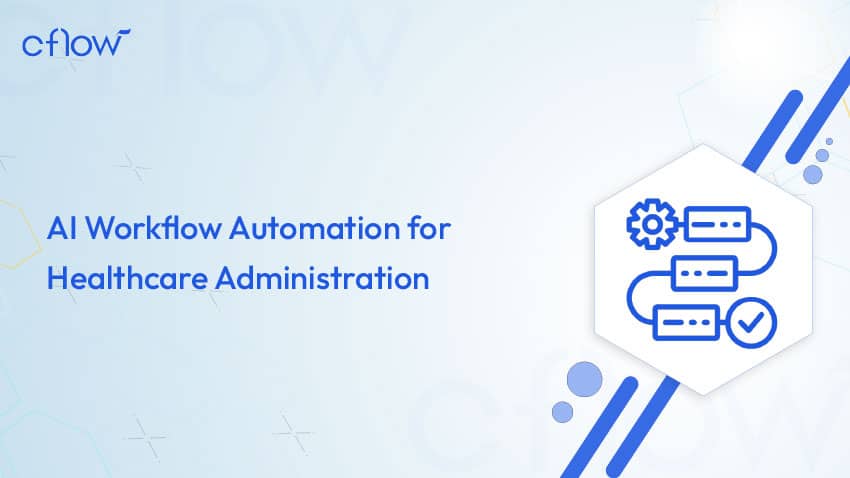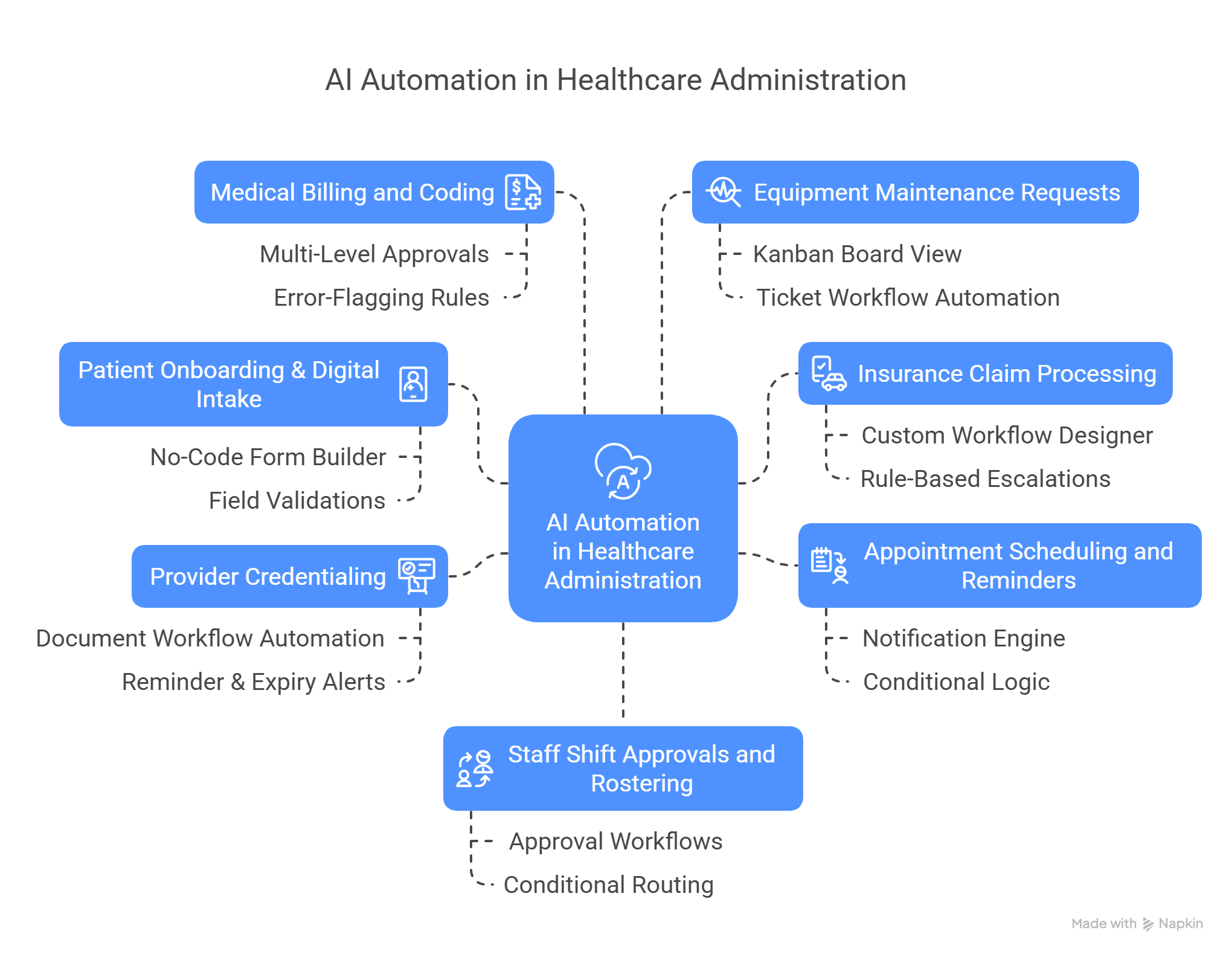AI Workflow Automation for Healthcare Admin Tasks

Key takeaways
- AI-powered workflow automation helps healthcare organisations streamline administrative tasks like onboarding, billing, and credentialing by reducing errors and eliminating manual handoffs.
- Automated routing and real-time tracking enable faster decision-making, reduce patient wait times, and improve overall operational turnaround.
- Cflow’s no-code platform empowers non-technical healthcare staff to build and manage workflows, accelerating digital transformation across departments.
- Automation improves compliance by enforcing standardised processes, maintaining audit trails, and supporting HIPAA, GDPR, and ISO requirements.
- Real-time dashboards and AI insights give administrators greater visibility into task status, SLA breaches, and performance metrics for smarter resource allocation.
The healthcare industry is under constant pressure to deliver faster, more accurate, and patient-centric services. But behind the scenes, administrative inefficiencies often slow down operations – manual paperwork, data entry errors, and delayed approvals lead to longer wait times and higher operational costs. This is where AI workflow automation steps in as a game-changer.
AI-powered workflow automation helps healthcare organisations optimise their administrative processes by eliminating bottlenecks, reducing human error, and speeding up decision-making. From patient intake to claims processing, automating routine workflows ensures that healthcare staff can focus on what truly matters—providing exceptional care.
In this blog, we’ll explore how AI-driven workflow automation is revolutionising healthcare administration and how platforms like Cflow can help healthcare providers stay compliant, efficient, and responsive.
What is AI Workflow Automation in Healthcare?
AI workflow automation in healthcare refers to the use of artificial intelligence to manage and streamline administrative processes such as scheduling, documentation, approvals, and claims. Unlike traditional automation, which follows rigid rule-based systems, AI introduces learning and intelligence, adapting workflows based on patterns, outcomes, and real-time data.
For example, an AI engine can:
- Prioritise urgent patient cases for review.
- Auto-fill patient data fields based on prior records.
- Predict claim denials and flag them in advance.
In healthcare, where every second matters and compliance is non-negotiable, AI workflow automation ensures that operations run with precision, speed, and reliability. It minimises friction between administrative departments and creates a seamless data flow across the organisation.
Why Healthcare Administration Needs AI Automation
Healthcare administration is overwhelmed by an ever-growing volume of tasks—from processing insurance claims to managing provider credentials. These tasks, though critical, are repetitive and prone to error when done manually.
Additional pressures include:
- Regulatory compliance with HIPAA, GDPR, and ISO standards.
- Rising operational costs and tighter budgets.
- The need for faster response times and real-time updates.
- Data security and auditability.
AI workflow automation tackles these pain points by digitising processes, auto-routing tasks to the right personnel, and providing real-time visibility. It allows healthcare teams to work smarter, not harder.
Top Healthcare Admin Tasks That Can Be Automated with AI
Many healthcare administrative tasks are repetitive, time-consuming, and prone to error when handled manually. By leveraging AI workflow automation, these processes can be streamlined to improve accuracy, speed, and staff efficiency.
Below are the top admin tasks that benefit most from automation in healthcare.
1. Patient Onboarding & Digital Intake
Patient onboarding typically involves collecting personal details, insurance information, and medical history through paper forms or basic digital inputs. These forms are then routed manually to various departments like billing or clinical support, often causing delays and data inconsistencies.
Cflow features to help the task to automate:
- No-Code Form Builder: Create customised digital intake forms.
- Field Validations: Ensure accurate data is captured upfront.
- Workflow Routing Rules: Automatically direct forms to the appropriate departments.
- Mobile Accessibility: Enable patients to complete forms via tablets or mobile devices.
2. Insurance Claim Processing
This task includes verifying patient coverage, validating supporting documents, and ensuring all required information is submitted correctly. Manual handling leads to frequent claim rejections and follow-ups.
Cflow features to help the task to automate:
- Custom Workflow Designer: Build end-to-end claim approval workflows.
- Rule-Based Escalations: Alert teams when claims are pending or delayed.
- Document Upload & Validation: Collect and validate insurance documents with minimal human intervention.
- Audit Trails: Maintain a detailed log of actions for compliance and tracking.
3. Appointment Scheduling and Reminders
Scheduling patient appointments and sending follow-ups is often managed through spreadsheets or standalone booking tools. Without automation, it’s easy to miss reminders or double-book appointments.
Cflow features to help the task to automate:
- Notification Engine: Automatically send confirmations and reminders via email or SMS.
- Conditional Logic: Route bookings based on staff availability or priority.
- Calendar Integration: Sync appointments with internal schedules.
- Task Reminders: Set alerts for missed or upcoming appointments.
4. Provider Credentialing
Credentialing involves collecting and verifying licenses, certifications, and background documents. Missed renewals or disorganised credential records can lead to regulatory issues.
Cflow features to help the task to automate:
- Document Workflow Automation: Automatically route credentialing forms to reviewers.
- Reminder & Expiry Alerts: Notify teams before licenses expire.
- Checklist Management: Track all required documents and approvals.
- Role-Based Access Control: Restrict access to sensitive information based on user roles.
5. Medical Billing and Coding
Accurate billing and coding are crucial for timely reimbursements. Manual approvals and misentries can cause delays or claim denials.
Cflow features to help the task to automate:
- Multi-Level Approvals: Route bills through coding and finance teams for faster processing.
- Form Calculations: Automate computation of totals, discounts, or tax.
- Error-Flagging Rules: Automatically detect and flag coding discrepancies.
- Custom Reports: Generate billing status reports for finance audits and review.
6. Equipment Maintenance Requests
Hospitals must manage maintenance schedules and repair requests for medical equipment. Delayed repairs impact service delivery and patient safety.
Cflow features to help the task to automate:
- Kanban Board View: Visually track open, in-progress, and resolved tickets.
- Ticket Workflow Automation: Log service issues and route to the maintenance team.
- Due Date Tracking: Monitor timelines and send reminders for pending repairs.
- Attachment Support: Include photos or documents with maintenance requests.
7. Staff Shift Approvals and Rostering
Managing shifts manually leads to overlapping schedules, missed approvals, and miscommunication. Automation helps streamline shift requests and approvals for better workforce management.
Cflow features to help the task to automate:
- Approval Workflows: Route shift requests to the appropriate department heads.
- Conditional Routing: Automate approvals based on role, department, or availability.
- Calendar View & Reminders: Provide visibility into upcoming rosters and send alerts.
- Workflow Cloning: Replicate weekly or monthly schedules to save time.
AI Workflow Automation in Healthcare – Key Task and Feature Mapping
The table below lists key healthcare admin tasks and the corresponding Cflow features that automate them.
| Healthcare Admin Task | Cflow Features to Automate the Task |
|---|---|
| Patient Onboarding & Digital Intake |
|
| Insurance Claim Processing |
|
| Appointment Scheduling and Reminders |
|
| Provider Credentialing |
|
| Medical Billing and Coding |
|
| Equipment Maintenance Requests |
|
| Staff Shift Approvals and Rostering |
|
Key Benefits of AI Workflow Automation in Healthcare
Improved Accuracy
AI-powered validations reduce human errors in form submissions, coding, and approvals. This means better documentation and fewer compliance risks.
Organisations can ensure higher data integrity across departments with consistent and structured data input.
- A study by Formstack revealed that 32% of companies experienced fewer human errors after implementing workflow automation, leading to increased productivity and accuracy. Formstack
- In claims assessment, workflow automation enables insurers to process claims with 30% greater accuracy by minimising human error and reducing the need for manual follow-ups. Feathery
Faster Turnaround
Automated routing ensures that no request or form gets “stuck” in someone’s inbox. Tasks move seamlessly from initiation to approval.
This leads to quicker patient service delivery and improved overall operational flow.
- Automation in claims processing has enabled insurers to handle claims with 30% greater accuracy, minimising human error and reducing the need for manual follow-ups. Feathery
Reduced Workload
By offloading repetitive admin work to automation, staff can focus on value-added tasks such as patient engagement or clinical coordination.
It helps reduce burnout among healthcare workers by eliminating unnecessary manual tasks.
- A study highlighted that digital technologies, including workflow automation, can reduce annual expenditures by more than 10%, while also lessening stressors on staff. MedCity News
Regulatory Compliance
AI workflows create consistent processes with built-in checks and audit trails. Cflow supports HIPAA, GDPR, and ISO compliance frameworks.
Automated compliance ensures readiness for audits and reduces the risk of penalties.
- Automated compliance workflows have been shown to improve reporting accuracy and speed by 30–40%, allowing healthcare institutions to adhere to industry regulations with minimal manual oversight. Feathery
Data-Driven Decisions
Cflow’s real-time dashboards and AI-driven insights give administrators better control over task status, SLA breaches, and performance metrics.
This data visibility enables proactive management and smarter resource planning.
- Implementing data-driven clinical productivity systems has resulted in a 30% increase in revenue and a 25% rise in treatment plan completion within just three months. arXiv
Real-Life Example: Automating Patient Intake in Clinics
Imagine a multi-speciality clinic receiving 100+ new patient registrations a day. Manually handling intake forms, insurance checks, and appointment scheduling leads to delays and patient dissatisfaction.
With Cflow:
- Patients fill out digital forms on arrival.
- Insurance data is validated via AI checks.
- Appointments are auto-scheduled based on doctor availability.
- Staff get real-time task assignments on their dashboard.
The result? A 30% faster onboarding process, higher patient satisfaction, and zero data entry errors.
How Cflow Supports AI Workflow Automation in Healthcare
1. Visual Workflow Builder for Non-IT Staff
Cflow’s drag-and-drop interface allows healthcare teams to build and customise workflows without writing a single line of code. Admin staff can quickly automate everything from referral management to supply requests.
2. Pre-Built Templates for Healthcare Use Cases
Whether it’s insurance claims, credentialing, or incident reporting, Cflow offers ready-to-use templates that can be tailored to your organisation’s unique needs.
3. AI-Driven Task Routing, Escalation, and Compliance
With Cflow’s AI logic:
- Tasks are auto-assigned based on role, workload, or priority.
- Escalations happen in real-time if SLAs are missed.
- Audit trails are automatically maintained, supporting compliance audits.
End-to-end workflow automation
Build fully-customizable, no code process workflows in a jiffy.
Comparison: Manual vs. Cflow’s AI Workflow Automation
The table below highlights how Cflow improves common healthcare admin processes compared to manual workflows.
| Process | Manual Workflow | With Cflow AI Automation |
|---|---|---|
| Patient Onboarding | Paper forms, delays, missing data | Digital forms, auto-routing, AI validation |
| Insurance Claim Approval | Manual checks, errors, slow follow-ups | AI checks, real-time tracking |
| Provider Credentialing | Email-based back-and-forth | Automated document flow with reminders |
| Maintenance Ticketing | Verbal or email requests | Workflow-based ticketing, real-time status |
How to Get Started with AI Workflow Automation in Healthcare
Implementing AI-powered automation in healthcare administration doesn’t have to be overwhelming. By following a structured approach, healthcare organisations can digitise workflows efficiently and begin seeing results in a matter of weeks.
1. Identify Repetitive Admin Processes
Begin by mapping out your existing administrative tasks. Look for high-volume, manual processes that are time-consuming and prone to error, such as patient intake, billing approvals, insurance claim submissions, and staff rostering. These tasks are ideal starting points for automation because they follow predictable steps and consume valuable staff time.
By targeting these areas first, you can achieve quick wins and demonstrate the value of automation to stakeholders.
2. Use a No-Code Platform like Cflow
Once processes are identified, choose a no-code automation platform like Cflow to build and deploy your workflows. Cflow offers a drag-and-drop visual interface that allows non-technical users, such as operations managers or clinical administrators, to design, modify, and launch automated workflows without needing IT support.
This speeds up implementation, reduces dependency on developers, and empowers teams to take ownership of process improvement.
3. Train Staff and Encourage Adoption
Successful automation depends on staff engagement. Conduct brief training sessions to introduce the new workflows and demonstrate how they simplify daily tasks. Focus on showing the ease of use and time-saving benefits to encourage buy-in.
Consider assigning internal champions or process owners to support adoption and act as go-to resources for team members.
4. Track KPIs and Improve Continuously
After implementation, monitor key performance indicators (KPIs) such as task completion time, approval turnaround, and error rates. Cflow’s real-time analytics dashboard provides insight into workflow efficiency and highlights process bottlenecks.
Use this data to refine your workflows, make informed decisions, and ensure continuous improvement across all departments.
Conclusion
AI workflow automation isn’t just a trend in healthcare—it’s a necessity. Healthcare organisations in the UK are under increasing pressure to do more with less. By adopting AI-powered workflow automation, administrative teams can eliminate bottlenecks, improve compliance, and enhance the patient journey. Cflow enables NHS trusts, clinics, and private hospitals to digitise workflows quickly and securely, without needing IT teams.
Want to experience hassle-free healthcare administration?
Start your free trial with Cflow today and take the first step towards smarter operations.
Frequently Asked Questions
What role can AI workflow automation play in healthcare?
AI workflow automation helps healthcare organisations reduce manual work, speed up approvals, and improve accuracy in tasks like patient onboarding, billing, and claims. It ensures that data flows smoothly across departments, reduces errors, and allows staff to focus more on patient care instead of repetitive administrative work.
How to use AI in healthcare administration?
You can use AI in healthcare administration to automate tasks such as appointment scheduling, claims processing, and document approvals. AI tools help route tasks to the right people, check data for errors, and track status updates in real time, making daily operations faster and more accurate.
What is process automation in healthcare?
Process automation in healthcare means using software tools to perform routine tasks automatically, like handling forms, approvals, or reminders, without manual input. It helps save time, reduces errors, and ensures every step in a process follows the same rules, improving efficiency in hospitals and clinics.
What is the role of AI workflow automation in the future of healthcare?
AI workflow automation will play a big role in making healthcare faster, safer, and more cost-effective. It will help hospitals run smoothly by reducing paperwork, speeding up decisions, and keeping records accurate, freeing up staff to spend more time on patient care and less on admin work.
How will AI workflow automation transform healthcare?
AI workflow automation will transform healthcare by digitising routine processes like billing, credentialing, and shift scheduling. It reduces delays, lowers costs, and improves compliance. As a result, healthcare teams can respond quicker, avoid errors, and deliver better experiences for both staff and patients.
Automate your workflows with our Cflow experts.What would you like to do next?
Get your workflows automated for FREE


